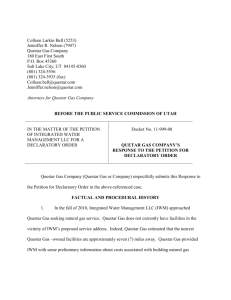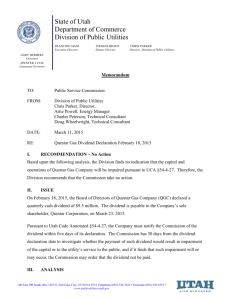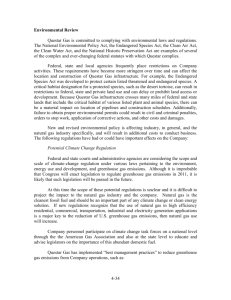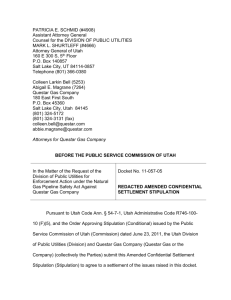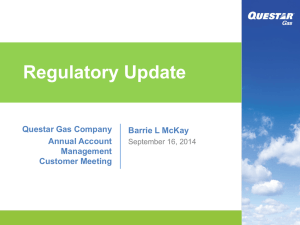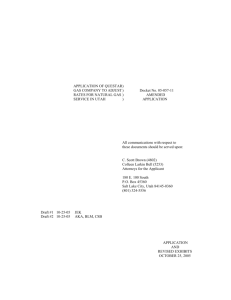Exhibit 7 - Utah Public Service Commission
advertisement
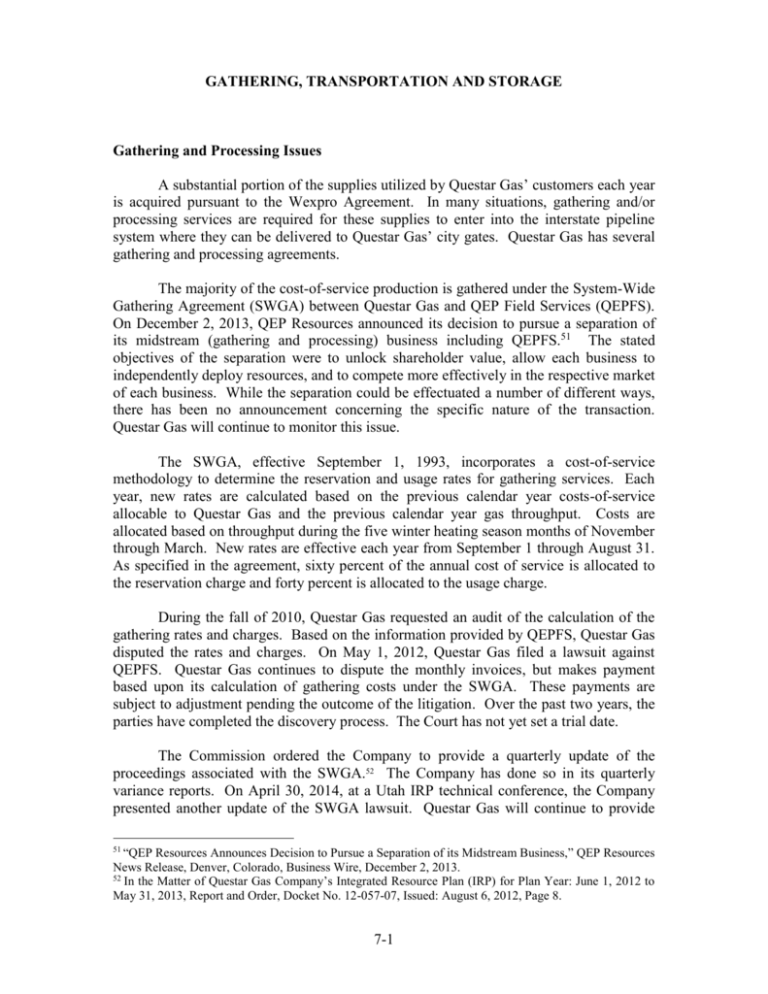
GATHERING, TRANSPORTATION AND STORAGE Gathering and Processing Issues A substantial portion of the supplies utilized by Questar Gas’ customers each year is acquired pursuant to the Wexpro Agreement. In many situations, gathering and/or processing services are required for these supplies to enter into the interstate pipeline system where they can be delivered to Questar Gas’ city gates. Questar Gas has several gathering and processing agreements. The majority of the cost-of-service production is gathered under the System-Wide Gathering Agreement (SWGA) between Questar Gas and QEP Field Services (QEPFS). On December 2, 2013, QEP Resources announced its decision to pursue a separation of its midstream (gathering and processing) business including QEPFS.51 The stated objectives of the separation were to unlock shareholder value, allow each business to independently deploy resources, and to compete more effectively in the respective market of each business. While the separation could be effectuated a number of different ways, there has been no announcement concerning the specific nature of the transaction. Questar Gas will continue to monitor this issue. The SWGA, effective September 1, 1993, incorporates a cost-of-service methodology to determine the reservation and usage rates for gathering services. Each year, new rates are calculated based on the previous calendar year costs-of-service allocable to Questar Gas and the previous calendar year gas throughput. Costs are allocated based on throughput during the five winter heating season months of November through March. New rates are effective each year from September 1 through August 31. As specified in the agreement, sixty percent of the annual cost of service is allocated to the reservation charge and forty percent is allocated to the usage charge. During the fall of 2010, Questar Gas requested an audit of the calculation of the gathering rates and charges. Based on the information provided by QEPFS, Questar Gas disputed the rates and charges. On May 1, 2012, Questar Gas filed a lawsuit against QEPFS. Questar Gas continues to dispute the monthly invoices, but makes payment based upon its calculation of gathering costs under the SWGA. These payments are subject to adjustment pending the outcome of the litigation. Over the past two years, the parties have completed the discovery process. The Court has not yet set a trial date. The Commission ordered the Company to provide a quarterly update of the proceedings associated with the SWGA.52 The Company has done so in its quarterly variance reports. On April 30, 2014, at a Utah IRP technical conference, the Company presented another update of the SWGA lawsuit. Questar Gas will continue to provide “QEP Resources Announces Decision to Pursue a Separation of its Midstream Business,” QEP Resources News Release, Denver, Colorado, Business Wire, December 2, 2013. 52 In the Matter of Questar Gas Company’s Integrated Resource Plan (IRP) for Plan Year: June 1, 2012 to May 31, 2013, Report and Order, Docket No. 12-057-07, Issued: August 6, 2012, Page 8. 51 7-1 regular updates and when final results of proceedings are available, they will be provided to regulatory agencies. Questar Gas includes cost data for the gathering and processing functions each year in the SENDOUT modeling process. Questar Gas used an estimate of what it believes should be charged under the SWGA in this year’s modeling process. The modeling may be revised when the SWGA gathering dispute is resolved. The SENDOUT model uses a logical gas supply network to define the relationships between modeling variables. Exhibit 7.1 illustrates those logical relationships for the gathering, processing and transportation functions as utilized by the model. Transportation Issues Questar Gas holds firm transportation contracts on Questar Pipeline, Kern River and Northwest Pipeline. Questar Gas continues to review capacity requirements to determine the amount of transportation required. As part of the five-year planning process, Questar Gas will evaluate its existing contracts including the Contract No. 241 with Questar Pipeline, Contract No. 1715 with Kern River, and Contract Nos. 139525, 139527, and 139528 with Williams Northwest Pipeline. 5-Year Contract Planning Process Questar Gas does not have any existing contracts that are nearing expiration. However, Questar Gas continues to evaluate contracts on a 5-year planning basis. Questar Gas has a contract with Northwest Pipeline for 2,295 Dth/d of transportation capacity that has a term expiration of 4/30/17. Questar Gas has two contracts with Questar Pipeline for 3,727,500 Dth and one for 5,964,000 Dth of storage in Clay Basin. They have term expirations of 4/30/2017, 3/31/2020 and 4/30/2019 respectively. Questar Gas also has two contracts with Questar Pipeline for 798,902 Dth/d and 12,000/87,000 Dth/d (depending on season) of transportation capacity that have term expirations of 6/30/2017 and 3/31/2018, respectively. Questar Gas has a contract with Kern River Gas Transmission for 53,000 Dth/d of transportation capacity that has a term expiration of 4/30/2018. Questar Gas also has a contract with Questar Pipeline for 184,625 Dth/d of peak-shaving deliverability from three gas-storage aquifers that have term expirations of 8/31/2018. Questar Gas will continue to look for ways to optimize the use of these contracts and evaluate options for their renewal or expiration. All options will be evaluated based on criteria to provide safe, reliable and cost-effective service to customers. Contracting decisions will be made based on current and forecasted needs as well as current and projected availability and cost. 7-2 Kern River Rate Case Questar Gas is a relatively small shipper on Kern River’s system, holding 50,000 Dth per day of seasonal capacity and 3,000 Dth per day of year-round capacity. Additionally, Questar Gas has a contract for 1,885 Dth per day of year-round capacity. Kern River filed a rate case in 2004. Questar Gas provided a detailed description of the Kern River rate case proceedings in its 2012 and 2013 IRP documents. The Company noted that in 2013, Kern River petitioned the United States Court of Appeals for the District of Columbia Circuit (D.C. Circuit Court) for review of the FERC order in its rate case. Questar Gas, and other entities, intervened in that appeal. A number of parties to the case have also sought clarification of the FERC’s order in that matter. The parties will submit briefs in the matter over the course of the summer of 2014. Questar Gas continues its active involvement and awaits a decision by the D.C. Circuit Court. No-Notice Transportation (NNT) Service On April 8, 1992, the FERC issued Order 636 which required interstate pipeline accompanies to unbundle their sales and transportation services ensuring that all natural gas suppliers could receive the same quality of transportation services. No-notice transportation service was among those services which the FERC required interstate pipeline companies to provide on an unbundled basis. FERC explained the requirement to provide this service in Order 636 as follows: As discussed above, the Commission is adding Section 284.8 (a)(4) to its regulations to require pipelines to provide a "nonotice" firm transportation service if they are providing a "nonotice" bundled, city-gate, firm sales service on the effective date of this rule. The Commission expects the pipelines and all interested participants to craft in the restructuring proceedings the operating conditions needed to ensure that the pipelines can provide a "no-notice" transportation service pursuant to which firm shippers can receive delivery of gas on demand up to their firm entitlements on a daily basis without incurring daily balancing and scheduling penalties. This "no-notice" service will enable pipeline customers to continue to receive unnominated volumes to meet unexpected requirements caused, for example, by unexpected changes in temperature. Thus, pipeline customers will be able to receive varying volumes of gas to meet their fluctuating needs during a twenty-four hour period. So, for example, constant rate of flow requirements would not apply to prohibit delivery on demand throughout the day up to a customer's daily firm entitlement under this service.53 53 FERC Order No.636, Final Rule, Docket Nos. RM91-11-000 and RM87-34-065, pages 88-89. 7-3 In FERC Order No. 636-A, issued August 3, 1992, the FERC shed additional light on its previous order by providing: The Commission clarifies that former bundled sales customers are entitled to receive the same quality and quantity of transportation service they were previously receiving as part of their sales service before unbundling.54 Questar Gas was entitled to receive NNT service from Questar Pipeline because it had been receiving “’no-notice’ bundled, city-gate, firm sales service” from Questar Pipeline previous to Order 636. In its Order 636 restructuring application, Questar Pipeline filed a NNT service rate schedule. In order to receive the same “quality and quantity of transportation service” needed previously, Questar Gas subscribed to this NNT service offered by Questar Pipeline. And, it was primarily the rationale given by the FERC which necessitated the receipt of this service by Questar Gas . . . “unexpected changes in temperature.” NNT service provides flexibility that allows Questar Gas to receive volumes of gas to meet demand caused, for example, by unexpected changes in temperatures.55 Temperatures within Questar Gas’ service area can be among the coldest in the nation. Temperature swings along the Wasatch Front can be large, sudden and difficult to predict. The daily and even hourly gas demand resulting from changes in temperatures can be substantial. NNT service provides Questar Gas the ability to provide service within this ever-changing environment. NNT service allows Questar Gas to reserve transportation and storage capacity on Questar Pipeline during the regular nomination cycles the day prior to actual gas flow. Questar Gas uses its NNT quantity to facilitate withdrawals and/or injections of gas utilizing Questar Gas’ capacity in Clay Basin and the aquifers in order to meet Questar Gas customers’ actual changing load without incurring overrun penalties and imbalances (see subsequent “Storage Issues” section). With its NNT service, as long as Questar Gas makes the gas supplies available on demand and reserves sufficient capacity with a NNT nomination, Questar Gas can make deliveries that exceed nominations in order to meet its actual demand requirements, and to avoid the nomination restrictions that would otherwise limit Questar Gas’ ability to match its nominations to its needs. NNT service also allows Questar Gas to take less gas than it nominates, if circumstances warrant, without incurring penalties or imbalances. NNT service does not give Questar Gas the right to exceed its daily contract capacity and the daily swings must be within the NNT quantity contracted for by Questar Gas. Questar Gas utilized its NNT every day throughout the 2013/2014 heating season. Questar Gas used NNT service 86 days during the heating season to reduce nominations by reducing withdrawals or injecting into storage. Questar Gas used NNT the 57 days to 54 FERC Order No. 636-A, Order Denying Rehearing in Part, Granting Rehearing in Part, and Clarifying Order No. 636, Docket Nos. RM91-11-002 and RM87-34-068, page 141. 55 For a more detailed discussion of the need for NNT service, see Questar Gas Company Integrated Resource Plan for Plan Year: May 1, 2008 to April 30, 2009, submitted May 1, 2008, pages 7-2 to 7-4 and Exhibits 7.2, 7.3 and 7.4. 7-4 provide for additional storage withdrawal. The maximum daily storage withdrawal reduction for the heating season was 155,333 Dth with an average daily withdrawal reduction of 56,156 Dth. The maximum daily storage withdrawal increase for the heating season was 203,542 Dth with an average daily increase of 81,736 Dth. The NNT usage for the heating season is shown in Figure 7.1 below. Figure 7.1: No Notice Transportation Usage – 2013/2014 Heating Season Questar Pipeline Gas Quality Questar Pipeline’s implementation of its Cricondentherm Hydrocarbon Dew Point (CHDP) provisions has worked well in recent years, as no major gas quality problems have occurred.56 By utilizing these provisions, Questar Pipeline has been effective in equitably meeting the delivery needs of its Shippers. The most prevalent measure of fuel gas interchangeability in the U.S. is the Wobbe Index.57 Natural gas appliances are rated to operate safely and efficiently within a specific Wobbe Index range. Questar Gas used a consulting firm to establish the Wobbe operating ranges for its service areas. For example, Exhibit 7.2 shows the upper and lower Wobbe operating limits for the Utah Wasatch Front (North) region for various levels of heating value and specific gravity. Questar Pipeline updated this exhibit this year to show the daily averages for 2013 of various sources of natural gas on Questar Pipeline’s system flowing to customers in this region. Charts for other Utah regions are also included this year (see Exhibit 7.3 and Exhibit 7.4). Exhibit 7.5 and Exhibit 7.6 56 Questar Pipeline Company, Docket No. RP07-457-000, FERC Gas Tariff Filing, May 18, 2007. The Wobbe Index number consists of the higher heating value of a fuel gas divided by the square root of the specific gravity (relative to air) of the fuel gas. Fuel gases with the same index number generate the same heat output over time from a burner given constant pressure and orifice size. 57 7-5 show the same information for the Wyoming eastern and western regions. The data for 2013 is similar to that for 2012, and, this year, no data points fall outside of the Wobbe operating limits in both Utah and Wyoming. In recent years, Wobbe values have generally trended downward due to the construction of natural-gas-liquids processing plants near natural gas fields flowing supplies into regional interstate pipelines. Should this become a concern in the future on any of the pipelines delivering gas to Questar Gas, there are a number of tools that can be used to manage gas interchangeability including injecting inert gases (or air) in the gas stream, injecting propane, and blending supplies from various sources. Though there are limits as to how much blending can take place on Questar Pipeline’s system, it is a reticulated system, characterized by a diversity of receipt and delivery points and a number of looped-line segments, which Questar Pipeline is able to utilize to optimize its deliveries for its Shippers. It is difficult to predict the interchangeability of future gas streams received by Questar Gas. The Company may need to arrange for additional processing or blending in the event it is required to ensure that the gas received from the transmission systems of either Questar Pipeline or Kern River are compatible with the needs of Questar Gas’ customers. Questar Gas will evaluate this on an ongoing basis as it bears the burden of processing pipeline-quality gas to meet its specific requirements. Storage Issues Questar Gas holds firm contracts for storage services at four underground gas storage fields to respond to seasonal winter and peak demands. The fields are Leroy, Coalville, Chalk Creek and Clay Basin. Leroy, Coalville, and Chalk Creek are aquifer storage facilities owned by Questar Pipeline that are utilized primarily for short term peaking. Questar Gas fully subscribes the aquifer facilities. Questar Gas is reviewing these storage resources as part of its fiveyear planning process. Clay Basin storage facility is a depleted dry gas reservoir used for both seasonal base load and peaking purposes. Clay Basin, also owned by Questar Pipeline, is utilized by both Questar Gas and other customers. Questar Gas’ inventory for its storage facilities is outlined in the following table: Table 7.1 Facility Clay Basin Leroy Coalville Chalk Creek Maximum Inventory (MDth) 13,419 886 720 321 7-6 The storage facilities of Leroy, Coalville, Chalk Creek, and Clay Basin are used as primary sources in conjunction with Questar Gas’ NNT service. The ability to reserve capacity and change nominations to match changing demands aids Questar Gas in meeting its daily load profile. Clay Basin Storage The Clay Basin storage facility is located in the northeast corner of Utah, roughly 50 miles from Rock Springs, Wyoming. The Clay Basin field has two producing sandstone formations, the Frontier and the Dakota. The Frontier formation is still producing natural gas today and the Dakota formation is used for storing gas. The Dakota formation was largely depleted by 1976 when construction of the storage facilities began. Today, the Clay Basin reservoir has the largest capacity of any underground storage facility in the Rocky Mountain Region. Questar Gas receives storage service at Clay Basin under rate schedule FSS. Billing under rate schedule FSS consists of two monthly reservation charges and separate per unit usage fees for injection and withdrawal. The first reservation charge is based on each shipper’s minimum required deliverability (MRD) as stated in each shipper's storage service agreement. The tariff provisions governing Clay Basin assure that customers will receive at least their MRD. To the extent that shippers have inventory in excess of that necessary for their last day of withdrawals, additional deliverability is available for allocation according to predetermined formulas. The second monthly reservation fee is an inventory capacity charge based on each shipper’s annual working gas quantity. During the 2013/2014 heating season Questar Gas utilized the Clay Basin storage facility to offset high natural gas prices, especially during the month of February. Questar Gas’ total gas purchases during February 2014 averaged over seven dollars per Dth. Questar Gas was able to withdraw over 2,100,000 Dth of gas from Clay Basin at a price less than five dollars per Dth during this month to offset the need to purchase high priced supplies. Questar Pipeline typically performs two inventory tests annually to verify that Clay Basin’s booked inventory matches the physical inventory. During the inventory tests Questar Pipeline must prohibit physical injections and withdrawals in order to accurately determine reservoir pressures. Data collected during the tests is used to determine whether Clay Basin’s booked inventory is physically in the reservoir. Leroy and Coalville Storage Since 2000, the operation of the Leroy and Coalville storage facilities have been modified to provide more flexibility and enhance storage efficiency. Following the end of the withdrawal season, the inventories in these facilities have maintained a working gas inventory of approximately 30–50% of maximum capacity through the summer months. Previous practice was to completely deplete the facilities each year at the end of the withdrawal season. The advantages of this revised mode of operation are as follows: 7-7 Wells in the aquifer storage are not “watered out” at the end of the withdrawal cycle, which improves well efficiency when storage injections are initiated in the fall. Injection compression fuel gas requirements are reduced (only 50-70% of the working capacity needs to be injected in the fall to fill the reservoir). A shorter, more predictable, and easily managed withdrawal/depletion schedule results at the end of the heating season. A shorter injection season for reservoir refill is required in the fall. With the aquifer inventories at 50%, the flexibility exists to inject significant volumes due to gas displacing water in the reservoir. In general, current operating practices at both the Leroy and Coalville facilities are as follows: Injections into the reservoirs commence in August or September from an initial inventory of approximately 45-55% of maximum working inventory. Injections continue until an inventory of approximately 75% of maximum is reached by early October. Injections follow a specific schedule determined by well and reservoir characteristics which minimizes the potential for “fingering” (gas being trapped behind water in the aquifer and resulting gas loss). In early October, scheduled aquifer injections are halted to facilitate Questar Pipeline’s testing program conducted at the Clay Basin storage facility. The testing requires two days of injection at a controlled rate followed by a 7-day no flow period for pressure stabilization. Depending upon system demand and the gas supply situation during the no flow period, the 75% inventory at Leroy and Coalville affords the flexibility to either inject or withdraw to help meet system balancing requirements. Following the Clay Basin test, controlled injections again commence in Coalville and Leroy with maximum inventory being reached by early November. The Company utilizes both Coalville and Leroy to meet peak load requirements through the heating season, to manage the morning and evening load swings on high demand days and to offset the cost of purchased gas during high-pricing event. During periods of lower winter demand, the Company refills the reservoirs to maximum inventory when possible. During March, when the need for peaking withdrawals has passed, the Company partially draws down the reservoirs to inventories of approximately 50% in preparation for Clay Basin testing (conducted during April). The April Clay Basin test consists of a one week withdrawal period followed by 2 days of controlled withdrawal. Following the withdrawal period, Questar Pipeline shuts Clay Basin in for 14 days for pressure stabilization. Maintaining Coalville and Leroy at the indicated inventory range during this period provides the flexibility to either inject or withdraw based upon system balancing needs. 7-8 At the end of the spring Clay Basin test, the Company then draws Leroy and Coalville down to inventory levels of approximately 45–55% and then maintains both at that level until refill commences in the fall. Periodically, Questar Gas will completely draw down one aquifer when necessary to conduct an inventory volume verification analysis. Chalk Creek Storage Due to the nature of the Chalk Creek storage formation and in order to minimize losses, Questar Pipeline does not currently practice partial inventory maintenance during the summer. Operation at Chalk Creek is as follows: Injections from zero working gas inventory commence in early November following a controlled injection profile. By mid-December, the reservoir reaches maximum inventory. In early March, Questar Pipeline blows the reservoir down in a controlled manner to zero working gas inventory and is then shut in until refill injections commence in the fall. Questar Pipeline places emphasis upon following these operating procedures in order to minimize gas losses and to ensure efficient storage facility operation. Questar Gas is currently working with Questar Pipeline to review the potential for increased usage to maximize the benefits of the aquifer. 2013-2014 Aquifer Usage As part of the ongoing evaluation of the Questar Gas contracts for peak-shaving services using the aquifers, Questar Gas has actively implemented improved plans to optimize their usage. High natural gas prices and high storage draws resulted in increased utilization and significant cost savings due to the aquifer usage during the 2013-2014 heating season. The aquifer usage, for both injection and withdrawal is shown in Figure 7.2. The Company also utilized the aquifers during the spring of 2014 to provide system flexibility during the spring Clay Basin test. As part of the Clay Basin test, Questar Pipeline issued an Operational Flow Order (OFO) limiting the physical injection into Clay Basin for an extended period of time. In order to continue to provide operational flexibility, the Company withdrew inventory from the aquifers in March in order to provide injection capabilities in the event of warm weather in April. The Company then heavily utilized the aquifers during the first three weeks of April for both injection and withdrawal. 7-9 Figure 7.2 –Aquifer Usage 2013-2014 Heating Season (thru April 2014) Clay Basin Gas Quality During 2007, when Questar Pipeline was resolving CHDP issues on its transmission system, it also remedied CHDP issues at its Clay Basin storage facility. Questar Pipeline and the Clay Basin storage customers reached, and the FERC approved, a “Stipulation and Agreement” in the matter.58 As a result of these FERC actions, Questar Pipeline refunctionalized the Kastler Processing Plant as a Clay Basin storage asset (it was previously a transmission asset) and installed additional processing facilities, thus ensuring a total delivery capability of 320,000 Dth per day to either Northwest Pipeline or Questar Pipeline. Questar Pipeline credits revenues received from the sale of natural gas liquids each year to the cost-of-service conditioning storage gas. Questar Pipeline returns any revenue above the cost-of-service to Clay Basin shippers. If revenue from liquids does not cover the cost of service, Clay Basin shippers pay an increased in-kind fuel reimbursement to make up the difference. On May 8, 2014, Questar Pipeline indicated that for the May 2013 through April 2014 time period, it expected that the liquids revenues will exceed the costs. Any such excess will result in a payment from Questar Pipeline during July of 2014. Preliminarily, the Company expects that the credit to Questar Gas will be roughly $16,000. The refunctionalization of the Kastler Plant and the installation of new processing facilities have effectively resolved the liquids issues at Clay Basin. 58 Federal Energy Regulatory Commission, Questar Pipeline Company, Docket Nos. RP07-606-000 and RP07-606-001, Letter Order Accepting Tariff Sheets dated November 7, 2007, “Reference: Stipulation, Petition, and Revised Tariff Sheets.” 7-10 Clay Basin Stipulation Gas Purchase Questar Pipeline revenues from liquids in 2012/2013 were short of the cost of service. Some shippers chose to pay their share of the shortfall “in-kind” with gas in Clay Basin. Questar Pipeline offered 880,000 Dth of gas they received through this stipulation process for sale through an open season bid process in October 2013. As part of this process, Questar Gas was successful in purchasing the 880,000 Dth as an in-place transfer in Clay Basin. Questar Gas had limited injections into Clay Basin during the summer of 2013 due to the expected need for storage capacity based on the forecast for cost-of-service production from Wexpro in the fall of 2013. Because production from Wexpro fell short of the forecast for that timeframe, Questar Gas felt it would be prudent to bid on the additional gas for storage. Based on the price paid for the gas and the eventual high cost of gas through the winter of 2013-2014, Questar Gas realized a significant savings for customers through this transaction. Ryckman Creek Gas Storage The Ryckman Creek storage project involves the utilization of a partially depleted oil and gas field located approximately 25 miles southwest of the Opal Hub in southwestern Wyoming (see Exhibit 7.7). The facility interconnects with Kern River, Questar Pipeline, Northwest Pipeline, Overthrust Pipeline and the Ruby Pipeline. Effective April 18, 2011, Questar Gas entered into a Firm Gas Storage Service Precedent Agreement with Ryckman for 2,500 MDth of storage capacity. Ryckman has been unable to withdraw gas that meets the gas quality standards of all of the interconnecting pipelines. In order to resolve this issue, Ryckman installed a nitrogen rejection unit (NRU). However, before it was fully operational, there was a fire at the NRU. On April 22, 2013, Ryckman posted a critical notice effective April 20, 2013, 5:38 PM, indicating that the storage facility had been shut down due to the fire and that force majeure had been invoked as per Section 6.19 of the Ryckman Tariff. All services were suspended. Storage services were subsequently reinstated without a resolution of the gas quality issue. To date, Questar Gas has made no injections into its 2,500 MDth of capacity under its Firm Gas Storage Service Precedent Agreement and has made no associated demand charge payments. Until Questar Gas commences storage services under the firm storage agreement, temporary storage capacity agreements will be considered on an as-needed basis. These agreements may include capacity release agreements and park-and-loan agreements. These agreements will be considered with any party that may have available storage at facilities including Ryckman Creek and Questar Pipeline. 7-11 Ryckman Creek Park-and-Loan In October of 2012, Questar Gas entered into a park-and-loan agreement with Ryckman Creek. The purpose of the contract was to provide injection capability during the October Clay Basin Test. Anticipated warm weather resulted in injection requirements above the injection capabilities of the aquifers. Questar Gas determined that a park-and-loan contract with Ryckman Creek was the most cost effective alternative. The terms of the agreement allowed for the storage of 138,000 Dth. The injection period was 10/5/2012 through 10/18/2012. The contract allowed for injection rates up to 23,000 Dth/day and withdrawal rates up to 4,600 Dth/day. Questar Gas injected 138,000 Dth under the agreement. On November 1, 2013, Questar Gas started nominating 13,800 Dth per day of withdrawal from Ryckman. By the tenth of the month, Questar Gas had withdrawn all of the 138,000 Dth it had injected under the park and loan agreement. Due to the gas quality issues, these withdrawals were brought about through displacement of volumes being injected into Ryckman Creek storage by another party. No physical withdrawals occurred at the facility. LNG Peak-Shaving Facility Questar Gas is currently evaluating the feasibility of an on-system storage facility for peak shaving. This facility could serve as a peak-shaving facility. As part of the evaluation, Questar Gas has contracted with a consultant, CH-IV International, to perform a “Conceptual Cost Study”. This analysis is underway due to the long-lead times required to complete an LNG storage facility project. Magnum Gas Storage The Magnum Gas Storage Project (Magnum) originally consisted of the construction and operation of a high deliverability, multi-cycle salt cavern storage facility, and a connecting header pipeline. The proposed caverns, with a working gas capacity of some 42 Bcf, have a planned location approximately one mile north of the town of Delta, Utah. Magnum anticipated that the project would be able to inject up to 0.3 Bcf per day and withdraw up to 0.5 Bcf per day with an inventory cycling capability of from nine to twelve times each year. The storage facility had been designed to interconnect with the interstate transmission systems of Kern River and Questar Pipeline near the town of Goshen, Utah. During March of 2012, Magnum notified the FERC that it was adding facilities to its project to facilitate the storage of natural gas liquids (NGLs) such as butane and propane.59 During June of 2012, Magnum requested an extension of its Construction Permit to begin the solution mining of the gas storage caverns from Utah State officials due to unforeseen changes in the natural gas markets.60 In a status report filed with the FERC on December 23, 2013, Magnum indicated for the reporting period of September to November of 2013, that the Magnum NGLs Storage Project site facilities construction 59 Notification of the Addition of State Jurisdictional Facilities within the Magnum Gas Storage Project Boundary, dated March 16, 2012. 60 Extension of Construction Permit, Magnum Gas Storage, LLC Evaporation Ponds, dated August 7, 2012. 7-12 had moved into the completion stage. Magnum also reported to the FERC that construction activities associated with the Magnum Gas Storage Project had not yet been initiated and that a revised construction schedule would be submitted following a review.61 On March 26, 2014, the Utah Board of Oil, Gas and Mining gave approval for the Magnum project to begin the storage of NGLs subject to favorable results from mechanical integrity tests overseen by the Utah Division of Water Quality beginning April 3, 2014. Product to be stored will be delivered off of a spur from a rail line serving the nearby Intermountain Power Project.62 Storage Modeling in SENDOUT The Company models the costs, contractual terms and operating parameters for each of its contracts with storage facilities in SENDOUT. A forecast of the storage inventory available at the beginning of the first gas-supply year is also needed for each storage facility for the SENDOUT modeling process. When Questar Gas modeled storage and inventory, it expected that the inventory at Clay Basin on June 1, 2014 would be approximately 1.3 Bcf. Other Issues Transportation Customer Nominations Questar Gas has been working with its Transportation customers and/or their agents to improve the nominations process on Questar Pipeline. The Company met with and continues to meet with interested parties in order to facilitate discussions on this topic and to exchange ideas. Gas Electric Coordination Natural gas is increasingly becoming the fuel of choice for electric generation. In an effort to better coordinate the scheduling timelines of natural gas pipelines with those of electric utilities, the FERC issued an order on March 20, 2014 to commence a rulemaking on the Coordination of the Scheduling Processes of Interstate Natural Gas Pipelines and Public Utilities (“NOPR”). FERC is proposing changes to: (1) the natural gas operating day (“Gas Day”); and (2) the natural gas intra-day scheduling practices. FERC is requesting comments from the natural gas and electric industries by November 28, 2014.63 Federal Energy Regulatory Commission, “Quarterly Compliance Summary Report,” Magnum Gas Storage, Docket No. CP10-22-000, December 23, 2013. 62 “Millard County Salt Dome to Begin Storing Liquid Fuel,” by Brian Maffly, The Salt Lake Tribune, March 27, 2014. 63 http://www.ferc.gov/media/news-releases/2014/2014-1/03-20-14-M-1.asp#.U5YnJ03jhaQ 61 7-13 FERC is providing the natural gas and electric industries until September 24, 2014 to reach a consensus through the North American Energy Standards Board (“NAESB”). By September 24, NAESB must notify FERC whether it has or has not reached a consensus. If the industries are unable to reach a consensus by September 24, FERC will go forward with the rulemaking. The FERC proposal could change the start of the Gas Day from 9 a.m. Central Clock Time (“CCT”), to instead begin at 4 a.m. CCT. FERC also proposes requiring all interstate natural gas pipelines to have standard natural gas scheduling practices across the country and proposes to add two additional Intra-Day nominations to the Gas Day. Gas Supply Adjustments between NAESB Cycles Questar Gas is also continuing to evaluate the Transportation customers’ continued use of the Company’s NNT and storage services to manage supply changes outside of the NAESB nomination cycles. Currently, Questar Gas’ sales customers pay for these services. The Company is considering a variety of options based on feedback from the transportation customers and/or their agents and an historical analysis of the needs of Transportation customers. 7-14

